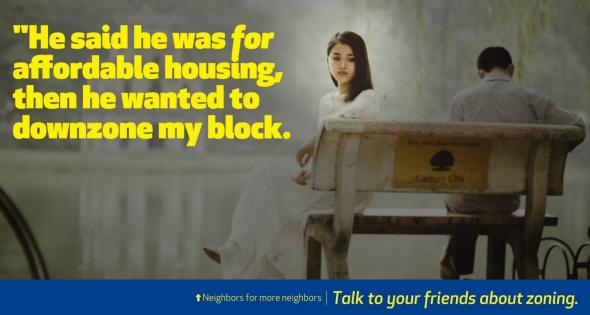Physical Address
304 North Cardinal St.
Dorchester Center, MA 02124
Physical Address
304 North Cardinal St.
Dorchester Center, MA 02124
A blog post in Pacific Standard seeks to defend rent control- an idea that, as the author admits, is generally detested by economists. The author writes that “rent regulations give tenants a greater stake in their community and incentivize them to put time, energy, and even money into their homes.” But that’s not necessarily a good thing- in a heavily regulated market, a “stake in the community” means that tenants, like homeowners, have an incentive to engage in NIMBYism. So in a prosperous area rent control hits housing supply with a double whammy- more recruits for the NIMBY army AND less incentive for landlords to invest in housing. He also endorses the “Unlimited Demand” theory, acknowledging the argument that building more market rate housing creates more affordable housing eventually, but responds: “not in tight markets like Silicon Valley and New York City. ” This claim is of course a self-fulfilling prophecy: people use it to justify opposing new housing, which in turn ensures that supply can never meet demand. (I critique the argument in more detail here). However, the article does contain one non-silly argument: that rent-controlled cities do occasionally experience building booms (most notably New York in the 1950s). Rent control is a factor relating to housing supply, but not the only one. So here’s my modest proposal for pro-regulation politicians: a city can adopt rent control to protect existing tenants, as long as they deregulate in other ways in order to promote new construction. So for example, a state law could provide that municipalities could adopt rent control under one condition: no more exclusion of new housing. So if San Mateo County wants to adopt rent control, they can do it as long as all new housing is exempt from all of the city’s use and density restrictions. The […]

Last week, I posted about an attack on YIMBYs (activists who favor less zoning and more housing) that used the term “alt-right”; the authors of that blog post recently doubled down with a slightly more moderate op-ed that still tarred YIMBYs as “aligned with conservative right-wing libertarianism.” In fact, the Obama Administration is on the same side as YIMBYs; I recently published an article about their 2016 policy paper on urban housing. Read all about it here.

The far-left “TruthOut” web page recently published an attack on YIMBYs,* describing them as an “Alt-Right” group (despite the fact that the Obama Administration is pro-YIMBY). I was surprised how little substance there was to the article; most of it was various ad-hominem attacks on YIMBY activists for cavorting with rich people. I only found two statements that even faintly resembled rational arguments. First, the article suggests that only current residents’ interests are worth considering in zoning policy, because “the people who haven’t yet moved in” most often means the tech industrialists, lured by high salaries, stock options and in-office employee benefits like massage therapists and handcrafted kombucha.” This statement is no different than President Trump’s suggestion that Mexican immigrants “[are] bringing drugs. They’re bringing crime. They’re rapists.” – that is, it is an unverifiable (if not bigoted) generalization about large numbers of people. Furthermore, it doesn’t make sense. The “tech industrialists” have the money to outbid everyone else, so they aren’t harmed by restrictive zoning. Second, the article states that academic papers aren’t as relevant as the actual experiences of San Franciscans displaced by high housing costs. In response to the argument that less regulation means cheaper housing, it states “tell that to people like Iris Canada, the 100-year-old Black woman who had used local regulations to stay in her home of six decades, only to be evicted in February.” So in other words, somebody was evicted in San Francisco, therefore San Francisco’s restrictive zoning prevents eviction. I don’t see how the latter follows from the former. The whole point of the YIMBY/market urbanist argument is that if there was more housing, there would be lower housing costs, hence fewer evictions. *For those of you who are unfamiliar with the term, YIMBY means “Yes In My Back Yard”, a […]

I just finished reading Richard Florida’s new book, The New Urban Crisis. Florida writes that part of this “crisis” is the exploding cost of housing in some prosperous cities. Does that make him a market urbanist? Yes, and no. On the one hand, Florida criticizes existing zoning laws and the NIMBYs who support them. He suggests that these policies not only raise housing prices, but by doing so harm the economy as a whole. For example, he writes that if “everyone who wanted to work in San Francisco could afford to live there, the city would see a 500 percent increase in jobs… On a national basis, [similar results] would add up to an annual wage increase of $8775 for the average worker, adding 13.5 percent to America’s GNP – a total gain of nearly $2 trillion” (p 27). On the other hand, Florida is not ready to endorse the idea that “we can make our cities more affordable… simply by getting rid of existing land use restrictions” because “the high cost of land in superstar neighborhoods makes it very hard if not impossible, for the private market to create affordable housing in their vicinity. Combine the high costs of land with the high costs of high-rise construction and the result is more high-end luxury housing.” (p. 28). I don’t find his point persuasive, for a variety of reasons. First, as I have written elsewhere, land prices are often quite volatile. Second, the overwhelming majority of any region’s housing is not particularly new; even in high-growth Houston, only 2 percent of housing units were built after 2010. Thus, new market-rate housing is likely to affect rents by affecting the price of older housing, rather than by bringing new cheap units into the market. Florida also writes that “too much density can […]
Thanks to Stephen Smith, I recently ran across an interesting database: HUD data on building permits by municipality. So I decided to find the number of permits per 1,000 for a wide variety of cities, focusing on (1) multifamily permits (because rising rent is a bigger problem in most places than rising home costs) and (2) during 2015 and 2016 (because isn’t two years of data always better than one?). Here’s what I found for the places I bothered to look up: Growing high cost cities permits per 1000/mean price for units with 5 or more structures in thousands Seattle 29.4 Denver 19.5 Washington 13.7 Boston 12.5 Portland 12.2 Brooklyn 11.5 Manhattan 10.1 San Francisco 8.8 San Diego 7.6 Los Angeles 6.7 Growing low cost cities Atlanta 28.7 Dallas 15.3 Nashville 14.6 Austin 13.2 (not sure whether this counts as a low-cost city- really its kind of borderline) Charlotte 12 Columbus 7.4 Houston 6.8 Indianapolis 2.3 Low demand (i.e. declining) cities Chicago 5.4 St. Louis 3.6 Cincinnati 2.3 Milwaukee 2.2 Baltimore 2.1 Detroit 1.4 Another fun fact: suburbs of expensive cities lagged behind even the low-demand cities. Nassau and Suffolk Counties had 0.3 and 0.2 multifamily permits per 1000 respectively, Marin County outside San Francisco 0.7, Orange County outside Los Angeles 4.7. Some takeaways: 1. Low-demand cities generally had less building than even the most restrictive cities. 2. Within the high-cost city group, it seems to me that there is a strong correlation between permits and prices: Seattle and Denver are certainly cheaper than San Francisco or Los Angeles. 3. On the other hand, there were some low-cost cities that didn’t have a lot of new construction, like Houston and Indianapolis. But this weirdness can be explained away by looking at new single-family construction: Houston had more than […]
A common argument against new housing supply is that in high-cost cities such as New York, demand from foreign buyers is so overwhelming as to make new supply irrelevant. A recent study (available here) by two business school professors suggests otherwise. The study does show more foreign involvement in the NYC market than I expected: just over 13 percent of Manhattan buyers, and 5 percent of all regional buyers, come from outside metropolitan New York. Even this share is less than in some lower-cost markets: the study notes that 17 percent of Las Vegas buyers are from outside the city. However, the impact of “out of town” buyers is pretty small: the authors conclude that out-of-town buyers “cause an increase in house prices of 1.1% and an 39 increase in rents by 1.6% in both zones.”
Matthew Yglesias has a group of tweets that begin with this: Someone needs to give me an Oscar one of these years so I can subject America to a tedious discussion of land use regulation. — Matthew Yglesias (@mattyglesias) February 27, 2017 “In the movies, there is no minimum lot size or maximum lot occupancy; we fill provide as much or as little parking as we want.” — Matthew Yglesias (@mattyglesias) February 27, 2017 “Fences is a powerful reminder that single-family zoning is not enough to make the American dream a reality.” — Matthew Yglesias (@mattyglesias) February 27, 2017

I am happy to announce that my new book “Government Intervention and Suburban Sprawl: The Case for Market Urbanism” is now available at Amazon. There is a “look inside the book” feature at the book’s Amazon webpage for those who would like to know more. I would like to thank not just the readers of this blog who commented on drafts, but also on those of you who helped me refine my thinking by commenting on blog posts.
One common argument against new housing is that permitting it causes land to become more valuable, thus leading to higher rather than lower rents. It seems to me that this argument is unpersuasive for a few reasons. First, if it was true, places with permissive zoning would have higher rents rather than lower rents, as the possibility of building would cause land values to explode. Obviously this is not the case. Second, the argument leads to absurd results. If downzoning reduces land values, obviously the best way to ensure low rents is to prohibit as much housing as possible. Perhaps we could prohibit all housing not on five-acre lots. But suburbs with large-lot zoning tend to be pretty expensive, suggesting that such policies are more likely to increase property prices than to lower them. Third, the argument suggests that land costs are the primary determinant of rents. But in fact, land values are much more volatile. The Lincoln Institute has created a database of land value data, and shows huge swings in land prices. For example, in the New York City metro area, the land price (apparently per house) swung from $99,000 in 1996 to just over $433,000 in 2006, down to under $225,000 in 2012, and up to about $250,000 today. It goes without saying that rents and housing prices follow very different patterns.
Recently, I met someone who was trapped in a terrible apartment. Why “trapped”? For months (if not years) she had been in an adversarial relationship with both her landlord and her neighbors, but she can’t quite bring herself to leave. Why not? First, she is in a rent-stabilized apartment, and is afraid to give that up because such units are hard to find. Second, because of rent stabilization, she had made the sort of capital investments in her apartment–such as repairs–that are normally made by landlords, but neglected when they are overseeing these price controlled units. By contrast, in a normal city, my friend’s dysfunctional relationship with her apartment would have ended long ago: either the landlord would have evicted her (something very difficult in New York), or she would have moved to someplace less atrocious.